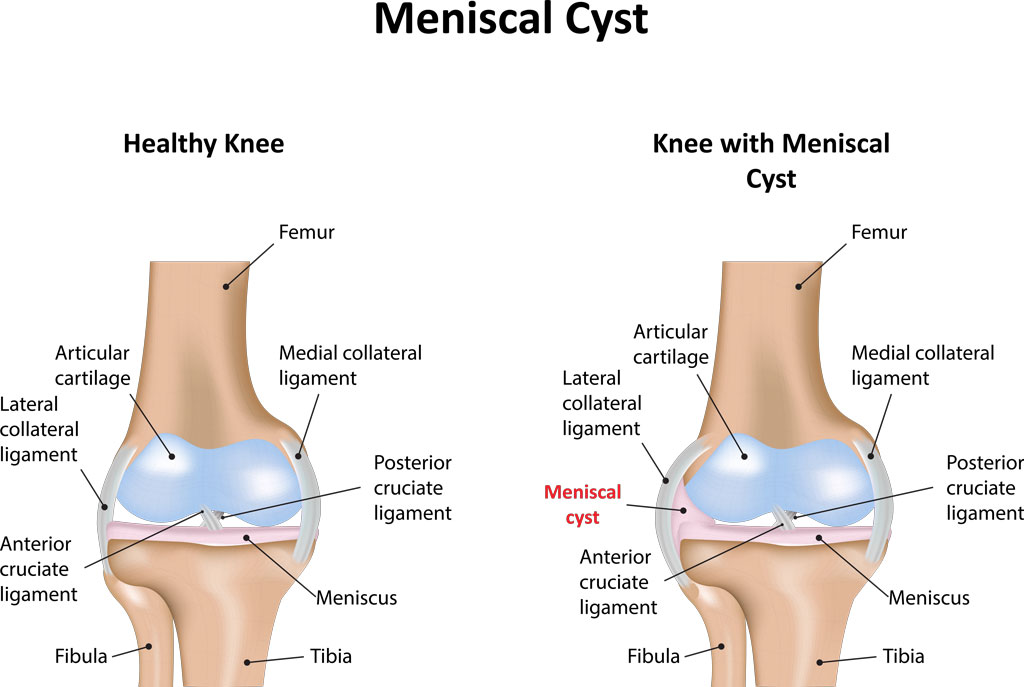- Home
- Treatment for Parameniscal Cyst
Treatment for Parameniscal Cyst
What is a parameniscal cyst?
If a meniscus tear has been present for a while then the fluid in our knee joint can leak out through the tear. The fluid will form a cyst. That fluid filled area is now called a “parameniscal cyst”. Sometimes these cysts can become quite large. Cysts that form on the inner part of the knee tend to be larger than cysts on the outer or lateral aspect of the knee.
Lateral meniscus cysts tend to be smaller than medial meniscus cysts because the very tight ITB tendon limits the growth of the cysts on the outside of our knee.
Lateral meniscus cysts also tend to hurt more than medial meniscus cysts because of the pressure they put on the ITB tendon.

Symptoms of a Meniscal Cyst
Meniscal cysts do not always cause symptoms. When they do, the most common are:
- Pain in the knee when standing
- Tenderness directly along the joint
- A bump or lump at the cyst site, usually near the outside of the knee
- A bump that becomes more visible as the knee straightens, though the bump itself may be painless
- A bump that changes size (though it may also remain seemingly unchanged)
- Swelling or locking of the knee joint
Meniscal cysts are most common in 20- to 30-year-old males. They are usually associated with a type of meniscal tear called a horizontal cleavage tear.
This kind of tear may be caused by over-rotation of the knee. It can also be caused by direct impact to the front or side of the knee.2 Disproportionate force on the knees, such as when you run on an uneven surface, can also cause this type of injury.
BOOK AN APPOINTMENT
“KNEEO Technique” For Knee Replacements
Diagnosis of Meniscal Cysts
A healthcare provider will ask you questions about:
- Knee pain
- Popping sounds
- Recent injuries or impact to the knee
This will help determine if you have a meniscal tear. A meniscal cyst can usually be palpated, which means a doctor can feel it.
Range of motion tests can confirm there are no torn pieces of cartilage in the joint.
There are a few tests doctors use to assess meniscal tears and other knee injuries. These include:
- The McMurray test
- The Apley test
- The Stienmann I test
- The Payr’s test
- Childress’ sign
- The Ege’s test
These are motion, weight-bearing, and pressure tests that can help doctors identify a tear. They can also help a doctor decide if the tear needs surgery.
Diagnosis may be confirmed by a magnetic resonance imaging (MRI) scan or ultrasound.
An MRI is a test that creates images of your knee using a magnetic field and radio waves. An ultrasound creates images using sound waves.
These tests will help your doctor see both the cyst and the tear
Treatment of Meniscal Cysts
Pain caused by a meniscal cyst can be treated with ice. Anti-inflammatory medications can also help. The cyst may be drained with a needle in a doctor’s office. Unfortunately, the cyst will usually return unless the meniscal tear is treated or heals itself.
Surgery
Meniscal tears don’t always need surgery. When they do, the most common surgery is a minimally invasive arthroscopic surgical approach. This is where a surgeon uses instruments passed through small incisions to operate on the joint.
Once the tear has been repaired, the cyst will usually go away. While it is possible for the cyst to come back, it is unlikely.


